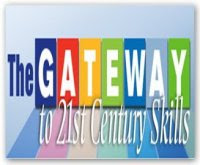Students rarely feel blasé about modern and contemporary art.
Generally speaking, they are either captivated by it or bemused by it – “Geez,
I could do that!” is a common response. Whatever their
attitude, student reaction to such art is honest and visceral. One byproduct of
the “I could do that” attitude towards modern art is that students often find
it more accessible and less intimidating than other types of art that stress
realism. Less intimidating material
tends to allow students to approach the subject with less trepidation and with
more tolerance regarding mistakes that can occur when creating their own
artwork.
Strictly speaking, contemporary art generally refers to art produced
since 1945, although the term now includes work done more recently. Modern art
usually describes a movement that began in the late 1800s and lasted until the
1970s, and includes types of art such as Surrealism, Cubism, Pop art, Fauvism,
and others. Since the contemporary and modern art movements overlap, the terms
are sometimes used interchangeably, although contemporary art more often
reflects social issues than modern art. Common themes in contemporary art, for
example, include human rights, economics, global warming, and politics, which
provide great opportunities for cross-curricular instruction. In many schools,
art instruction often focuses on more traditional forms of art, where students
often imitate the works of various famous artists. While this method certainly
has value, students can gain much more from the experience by simultaneously
learning about and discussing not only the elements and principles of art &
design, but also how to think, respond to, and express new ideas using a visual
language.
Art, however, is not simply about ideas. While one component of art
education is certainly to highlight and nurture the creative spark in every
student, students also learn valuable skills. Students learn how to translate
their ideas into a workable piece of art – a complex process that involves
planning, making mistakes, regrouping, editing, and execution. In this way,
students develop confidence in their abilities to create their own art, and to
think of new ways to express themselves through art. In developing these
skills, they also begin to learn how to critically approach and appreciate
various types of art. This week, I’ve selected three resources on modern and
contemporary art for various grade levels; many of the lessons are adaptable to
a range of ages. Throughout the week, I’ll also be featuring several new
lessons and resources daily on this topic on our Facebook and Twitter pages, so be
sure to give those a look.
A
Bug’s Journey
Subjects: Visual art, Language arts
Grade: 3-5
Students will explore contemporary artist John Baldessari's
mixed-media work of art inspired by a 16th-century drawing of a beetle. After
writing a story about a bug's journey, each student will create a mixed-media
representation of a bug that is inspired by the contemporary artist's work.
This lesson was created by the staff at the
J. Paul Getty Museum. The Museum offers a
host of resources for K-12 teachers and students, including professional
development opportunities, lesson plans, and interactive art features.
Color
Scramble
Subjects: Visual arts
Grade: 5-12
In the 1960’s, Frank Stella became known for his minimal geometric
paintings of concentric squares that used color to create visual movement. Each
concentric square of color related to the next, whether they were harmonic or
contrasting colors. In this lesson plan, students consider color relations and
“paint” a Stella-style work with colored masking tape. This lesson was produced
by Dick Blick Art Materials, a supplier of art goods for artists and educators.
Dick Blick also provides lesson plans for teachers that meet the National
Standards for Visual Art Education.
Introduction
to Modern Art: Practice and Principals
Subjects: Visual arts, Writing
Grades: 10-11
In this lesson, students learn about several Abstract Expressionists
and identify the ways in which they use color, line and form to express
themselves. Students will learn about such artists as Red Grooms, Frank Stella,
Stuart Davis, and Hans Hoffman. In addition, they will also learn about Stuart
Davis, whose color theory may be contrasted with Hofmann’s. This lesson was
created by PBS in support of its film Hans Hoffman: Artist/Teacher,
Teacher/Artist. PBS provides many preK-12 educational resources and
activities for educators tied to PBS programming, many of which are
correlated to local and national standards.
~ Joann's Picks - November 11, 2011~




